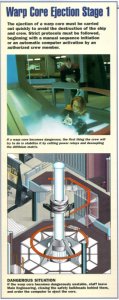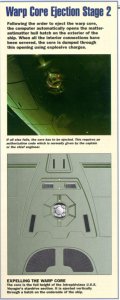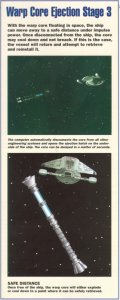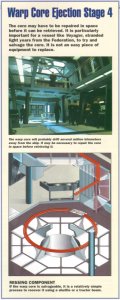 The warp engines function by annihilating matter and antimatter, generating an enormous amount of
energy. If the warp containment field collapses or the warp core becomes unstable, it can result in a
massive explosion that could easily destroy the ship. As a result, Voyager has been designed, like all
Federation starships, so that the warp core can be safely ejected in case of an emergency.
The warp engines function by annihilating matter and antimatter, generating an enormous amount of
energy. If the warp containment field collapses or the warp core becomes unstable, it can result in a
massive explosion that could easily destroy the ship. As a result, Voyager has been designed, like all
Federation starships, so that the warp core can be safely ejected in case of an emergency.
Starfleet protocols require that the warp core be retained if at all possible, and so power and fuel
supplies are automatically sealed off at points upstream from the damaged areas. A multilayered
forcefield is then deployed in an effort to contain the unstable core. If these measures fail, the
safety of the crew and ship becomes paramount, and the warp core must be ejected. The procedure for
warp core ejection involves initiating a manual sequence or automatic computer activation. The order
to eject a core can only be given by crew members with the necessary authoization, such as the captain,
first officer, or chief engineer. The next step is to engage the ejection system, while the magnetic
valves and transfer pipes connected to the warp core are dealt with automatically. When the order is
given, the computer opens or blows out the matter-antimatter reacation assembly exterior hull hatch,
which is located on the ventral side of the ship. The core is then forcibly ejected through this
hatch with explosive charges.
Once the core has been ejected, it will not necessarily breach; it may cool down in space, in which
case it can be retrieved. As the core will probably still be unstable, the crew have to perform repairs
before locking on a tractor beam and reconnecting the core to the engineering systems.





